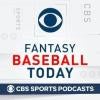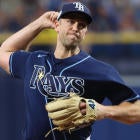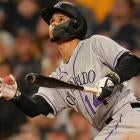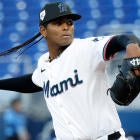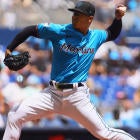Last year, we received this email from a Fantasy Baseball Today podcast listener:
"Hey guys. When you're using advanced stats in player discussions is there any way you could list other players with similar profiles for context? I personally feel like this will help translate what advanced stat profiles actually could mean for production. Thank you."
This is something we'll get every once in a while, and it's a fair request. Not everyone is up to date on the latest minutiae from around the baseball world, and all of these alphabet soup stats we throw at you can probably start to sound like nonsense at some point.
So, I took some time to compile a few of my most-cited advanced stats, with an explanation for what they measure, how to use them, and a few examples from last season to help explain what they mean in practice. We'll start with some of the more basic stuff, and then get into the really high-level numbers. If you have any other questions, please don't hesitate to email FantasyBaseball@CBSi.com so we can help.
BABIP
What does it mean? Batting Average on Balls In Play. It measures a hitter's success rate when taking strikeouts and home runs out of the question. We'll reference this one a lot.
Why does it matter? Batting average is probably the single stat that fluctuates the most from one year to the next, and BABIP represents where most of that noise comes from. Hitters have some control over their BABIP — hitting line drives, hitting the ball the opposite way, and being fast are three ways batters can control it — but there is a large component of luck or randomness to it. The league tends to aggregate around .300 BABIP, and the majority of hitters are going to be within 30 points of that one way or the other — though there are exceptions. Anything much higher or lower than that can typically be chalked up to luck, good or bad. Random variation around BABIP can often help explain outlier performances.
Some key results from 2019:
| | 10th %ile | 50th %ile | 90th %ile |
BABIP | 0.265 | 0.303 | 0.345 |
Example |
Altuve is actually an instructive example of how you can't just say everyone should have a BABIP around .300. For his career, he has a .337 BABIP, and hadn't been below .329 since 2013, so there might have been some bad luck here. The question is whether the diminished line drive rate in 2019 was a result of a declining skill set, or just some more randomness — line drive rate also fluctuates a lot every year.
Voit is a tougher cookie to crack, because he has a .347 BABIP in his MLB career, so this might be sustainable. However, the thing about BABIP is, because it is such a noisy stat, it takes a lot more than Voit's 795 career plate appearances to identify what a player's "true" skill level is. He might be a high BABIP player — he certainly hits the ball hard enough — however his lack of speed would suggest there is probably some room to decline there.
Where can you find it? FanGraphs.com has it on every player's page, along with yearly and career leaderboards.
BB%
What does it mean? Walks divided by plate appearances. About as straightforward as you can get.
Why does it matter? Getting on base is important, and walking is one of the best ways to do that. It's important to use rate stats rather than counting stats, to adjust for playing time, too.
Some key results from 2019:
| | 10th %ile | 50th %ile | 90th %ile |
| BB% | 5.1 | 8.8 | 13.7 |
| Example | Kevin Newman | Trevor Story | Mookie Betts |
This matters a bit less for Rotisserie scoring, where OBP isn't a direct scoring category, though the more you get on base, the more runs you'll score and stolen base opportunities you have. However, for H2H points, you'll want to give guys with a high walk rate a boost.
Where can you find it? FanGraphs.com has it on player pages. Or, you can just use a calculator.
K%
What does it mean? Strikeouts divided by plate appearances. Walk rate's cousin.
Why does it matter? Strikeouts aren't that much worse than regular outs, but they do represent a lost opportunity for production. A batted ball, even one weakly struck, can still turn into a hit. Not so for strikeouts. The more a player strikes out, the less likely they are to hit for average and produce counting stats — though if they do enough else well, they can still be very valuable. Just ask Aaron Judge.
Key results from 2019:
| | 10th %ile | 50th %ile | 90th %ile |
K% | 26.6 | 19.6 | 13.7 |
Example | D.J. LeMahieu |
As you can see, strikeout rate on its own might not tell you much. All other things being equal, you should prefer a hitter who doesn't strike out as much, but all other things are rarely equal. In this case, strikeout-prone hitters tend to hit for more power, and often walk more as well, so it ultimately comes down to why a hitter is striking out. Is it because, like Mike Trout, they are patient and selective, working deep counts to look for the right pitch? Or is it like Randal Grichuk, where they are just swinging from their heels, hoping to hit the ball far if they hit it?
Ultimately, it is better not to strike out then to strike out, but many players do enough to make up for that.
Where can you find it: FanGraphs.com or a calculator, again.
ISO
What does it mean? Isolated slugging percentage. Literally just slugging percentage minus batting average. Basically, we're trying to isolate how much power a player hits for, once you remove singles.
Why does it matter? We tend to think about power in terms of homers, but raw home run totals can fluctuate quite bit from year to year, while ISO takes into account doubles and triples, so a bad luck season won't necessarily look as bad here.
Key results from 2019:
| | 10th %ile | 50th %ile | 90th %ile |
ISO | 0.129 | 0.2 | 0.279 |
Example | Luke Voit |
This one doesn't need a lot of thinking over. Good power hitters hit for a lot of power. It is interesting to note that Luke Voit was actually more like an average power hitter in 2019, though it was a bit higher before the mid-summer hernia he suffered.
Where can you find it? FanGraphs.com. Or, again, a calculator.
HR/FB
What does it mean? Home runs divided by fly balls.
Why does it matter? Because home runs are relatively rare events, even for big time power hitters, luck can still play a pretty significant part in season-long homer totals. Great power hitters will sport high HR/FB rates, and it tracks pretty well with hard-hit rate and average exit velocity on line drives and fly balls, which are pretty good measures of raw power. Which makes intuitive sense: Players with more raw power should be expected to see more of their fly balls leave the park, because they are hitting them harder.
Key results from 2019:
| | 10th %ile | 50th %ile | 90th %ile |
HR/FB% | 8.8 | 15.8 | 24.8 |
Example |
First things first, you have to take into account the long-term trends with HR/FB rate in particular, because it has spiked dramatically in recent years. Here are the MLB averages for the past decade:
SEASON | HR/FB% |
2010 | 9.4% |
2011 | 9.7% |
2012 | 11.3% |
2013 | 10.5% |
2014 | 9.5% |
2015 | 11.4% |
2016 | 12.8% |
2017 | 13.7% |
2018 | 12.7% |
2019 | 15.3% |
The juiced ball plus an increased emphasis on hitting for power have combined to create an absolute explosion, to the point where what would have been pretty close to an average HR/FB rate in 2010 was in the 10th percentile in 2019. One thing that makes analyzing HR/FB rate tough is we just don't know if the ball will be juiced in 2020 — there is evidence to suggest it was not juiced in the postseason.
Where can you find it? FanGraphs.com.
Avg. Exit Velocity
What does it mean? How hard the ball comes off a hitter's bat, on average.
Why does it matter? It's pretty obvious why it matters: Hitting the ball hard is very good. All other things being equal, you want to hit the ball hard.
Key results from 2019:
| | 10th %ile | 50th %ile | 90th %ile |
AVG Exit Velo | 85.7 mph | 89.0 mph | 91.4 mph |
Example | Cesar Hernandez |
Yep, that tracks, though you might be surprised to learn how hard Hiura actually hit the ball last season. His power breakout may be for real.
However, one thing to consider when it comes to a stat like this is the average exit velocity isn't everything. Hitting the ball hard on the ground isn't as valuable as hitting it hard in the air, and hitting one ball 60 mph and another 120 mph isn't the same thing as hitting two at 90 mph. The best example of this might be Mike Trout, who ranked just 51st in average exit velocity, but mis-hits the ball about as rarely as anyone in baseball. Another example is Mitch Garver, who ranked 31st in baseball in average exit velocity at 91.1 mph, but was seventh in average exit velocity on fly balls and line drives at 97.2 mph.
Average exit velocity is a useful tool, but there are better ones in our arsenal that paint a more complete picture about quality of contact.
Where can you find it? BaseballSavant.com
Barrels
What does it mean? It's sort of convoluted, so I'll let MLB.com explain it:
Why does it matter? Barreled balls are usually going to lead to good results for a hitter. It's not just that he hit the ball hard, but that he hit it hard at a launch angle that typically leads to extra bases.
Key results from 2019:
| | 10th %ile | 50th %ile | 90th %ile |
Barrel % | 2.1 | 5.4 | 8.6 |
Example | Cesar Hernandez | Maikel Franco |
You can sort by both "barrels/batted ball event" and "barrels/PA," but the latter is the default. Generally speaking, Barrel rate is a good proxy for overall hitting ability, but because they are relatively rare events in and of themselves, they don't necessarily account for consistency. So, a player might have a high barrel rate, but still be a frustrating hitter, because he might hit an equal number of pop ups, or weak grounders.
Where can you find it? BaseballSavant.com
xBA
What does it mean? Expected batting average. Using Statcast data, every batted ball by a hitter is compared to similar batted balls to identify the chances of becoming a hit.
Why does it matter? It's a more elegant solution than just looking at BABIP and screaming "REGRESSION." This is where we start to see how much skill matters for batting average. Yoan Moncada's .315 average might be hard to sustain, but his .291 xBA suggests there may not be as much regression coming as you would think based on his career .265 average.
Some key results from 2019:
| | 10th %ile | 50th %ile | 90th %ile |
xBA | 0.232 | 0.262 | 0.291 |
Example |
What this tells us is that Goldschmidt's decline might be for real. His .262 xBA is his lowest in the five years BaseballSavant.com has on record, though he has typically outperformed that metric in the past. It's possible a combination of declining bat speed and foot speed may be making Goldschmidt look like a mortal after being the best first baseman in Fantasy for the better part of a decade.
However, one thing to keep in mind here is these statistics are descriptive, not predictive. What that means is they are attempting to describe what should have happened last season, based on how much a hitter struck out and how well he hit the ball. They don't necessarily tell us what will happen in the future, because quality of contact and strikeout rate don't necessarily hold consistent every year either.
Where can you find it? BaseballSavant.com is your home for all StatCast related metrics.
xwOBA
What does it mean? Expected wOBA.
What does 'wOBA' mean? Weighted On-Base Average. When we're talking about a player's total contributions at the plate, OPS is usually the go-to, because if you're playing Fantasy baseball in 2020, chances are you know what OPS means and what a good one looks like. wOBA is scaled similarly to on-base percentage, and it represents a hitters total contributions at the plate in a more nuanced way than OPS does, though the leaderboards for both will typically look close to identical.
Why does it matter? The same methods that go into xBA go into xwOBA, but they take into account expected slugging as well as a hitter's on-base percentage. The primary usage of xwOBA is to look at players who might have deserved better or worse results than they actually got. It is an attempt to quantify what a player's total production should have been, absent the impact of the defense or other factors outside of the hitter's control.
Some key results from 2019:
10th %ile | 50th %ile | 90th %ile | |
xwOBA | 0.292 | 0.331 | 0.378 |
Example |
As with xBA, there are certain types of hitters who can be reasonably expected to overperform their xwOBA, and Robles is a good example. He had a .317 wOBA, and that difference likely comes down to his ability to steal hits with his speed.
xwOBA is most useful when comparing to actual results to see who might have been the recipient of some good fortune versus who might have had a snakebitten season. 2019's biggest overperformer, Fernando Tatis, does stand out like a sore thumb. His elite speed should help him sustain some of that edge, but he'll need to take a step forward in his underlying skill set to remain an elite hitter.
Alex Bregman could also be someone to keep an eye on, though he has also outperformed his xwOBA in three of four major-league seasons. His incredible bat control could play a big part in that, as could the short right field porch in Minute Maid Park. Either way, you should expect some regression from his 41-homer 2019.
One place this metric sort of falls apart is when it comes to Coors Field — three Rockies were among the seven biggest xwOBA overperformers last season, and that just comes down to the effects of Coors Field on batted ball results. So, don't overreact to someone like Nolan Arenado being the second-biggest xwOBA overperformer in 2019.
On the other end of the spectrum, you had Marcell Ozuna, who underperformed his xwOBA by a whopping .046, the largest in the majors. His is a tough case, because it's harder for right-handed hitters to be harmed by the impact of shifting, and his above-average sprint speed shouldn't harm him either. He is one of the best bets as a bounce back candidate in the league, though it's also worth noting he has underperformed his xwOBA by at least 20 points in three of five tracked seasons. That might just be a "skill" he owns.
There's also good news for Danny Jansen and Dansby Swanson, two solid sleeper picks for 2020, as well as Franmil Reyes, one of my favorite breakout picks, and a possible home run leader for 2020.
I also want to point out Mookie Betts and Mike Trout, who actually could have had even better seasons in 2019, if you can believe it. Betts could be a value as the No. 6 pick on average, while Trout could make everyone who passed on him with the No. 1 pick look foolish. A career .348 BABIP hitter over 5,273 PA, Trout had just a .298 BABIP in 2019. I wrote about what a best-case scenario season could look like for Trout, and it remains terrifying.
Where can you find it? BaseballSavant.com is your home for all StatCast related metrics.
LD%
What does it mean? Line drive percentage. The share of all batted balls classified as line drives (by Baseball Info Solutions' tracking).
Why does it matter? There is a reasonably strong relationship between line drive rate and BABIP. It's not perfect — a higher line drive rate doesn't explain all of the variation in BABIP. But it gets us part of the way to explaining why some players can have more success on balls in play than others.
Key results from 2019:
10th %ile | 50th %ile | 90th %ile | |
LD% | 18.1 | 21.2 | 25.3 |
Example |
Ironically, these three examples illustrate the limitations of using line drive rate to explain BABIP. Baez actually had the highest BABIP of the group, while RIzzo had the lowest. That highlights one limitation of LD%: It's not terribly predictable year to year. It is a measure of how well a hitter hit the ball in any given year, but it doesn't always carry over from last year. It's a useful thing to know, but you shouldn't rely on it too much.
Where can I find it? FanGraphs.com
GB%
What does it mean? Groundball rate. Share of batted balls hit on the ground.
Why does it matter? Production doesn't live on the ground. Only sadness. You can get a single, maybe an occasional double or triple, on a ground ball. But unless the defense just trips all over themselves over and over, you aren't getting home on the ground. And with teams getting better and more aggressive with their usage of shifts, groundballs are becoming less and less desirable each year.
Key results from 2019:
10th %ile | 50th %ile | 90th %ile | |
GB% | 49.9 | 42.9 | 33.4 |
Example | Jose Altuve | Anthony Rizzo | Trevor Story |
One thing to note here is the gap between the extreme ends are starting to get smaller, as the game continues to optimize for batted balls in the air. Hitting the ball on the ground isn't the worst thing for a player like Altuve, who has excellent bat control and speed, though he traded line drives for ground balls last season, a trade off that helps explain his low BABIP.
Where can you find it? FanGraphs.com
FB%
What does it mean? Flyball rate. Share of batted balls that are fly balls.
Why does it matter? This is where power lives. You'll get the occasional line drive homer, but for the most part, home runs come from fly balls. The more fly balls you hit, the more chances you have for home runs. It doesn't mean it will always lead to more home runs, of course — you've still gotta have the raw power to make those fly balls count, as well as the aforementioned unpredictability of HR/FB rate to contend with.
Key results from 2019:
10th %ile | 50th %ile | 90th %ile | |
GB% | 28.7 | 35.6 | 44.6 |
Example | Cesar Hernandez |
One thing you want to guard against is the possibility of going too far and hitting pop ups too often. Fly ball% treats all fly balls the same, so if you're looking for a reason why a player is struggling, go look for infield fly ball rate, and that can often tell you the story. Infield fly balls are basically the worst outcome a hitter can have.
Where can you find it: Fangraphs.com
Also: You can use average launch angle as another proxy for these batted-ball numbers. The higher the average launch angle, the more balls that player is hitting in the air, though as with all averages, it can't necessarily differentiate between players who are consistent and players who fly from one extreme to the other. An infield fly ball and a weakly hit grounder may have the same average as two line drives, but the two line drives are obviously more productive hits.
Hard-hit%
What does it mean? Depends on who you're asking. BaseballSavant.com defines a "hard-hit ball" as any struck over 95 mph, while FanGraphs.com takes into account the ball's trajectory as well. For my money, I think it makes more sense to go with the StatCast definition of 95+ mph batted balls, because it's more clear.
Why does it matter? Hitting the ball hard is a good thing. It makes your ground balls more likely to go through a hole in the defense, and makes your fly balls and line drives more likely to turn into hits, especially of the extra-base variety.
Key results from 2019:
10th %ile | 50th %ile | 90th %ile | |
Hard-hit% | 28 | 39.1 | 47.1 |
Example |
Yeah, that makes sense. The most interesting players for 2019 are the true outliers, especially at the higher end. Miguel Sano (57.2%) and Aaron Judge (57.1%) were well clear of the field, with third place Nelson Cruz further from Judge than Cruz was from No. 33 Robinson Cano. Also: Yep, Cano was 33rd out of 250 hitters in hard-hit rate. His bat may not be quite as cooked as you think.
No. 32 is also notable: Eric Hosmer. He has talked about hitting the ball more the air this offseason, after sporting the second-lowest average launch angle of any player in the league in 2019.
Where you can find it: BaseballSavant.com, though FanGraphs.com also has their own slightly different version.
Sprint Speed
What does it mean? How fast a player runs the bases.
Why does it matter? Because it tells you fast a player runs. It's pretty straightforward.
Key results from 2019:
10th %ile | 50th %ile | 90th %ile | |
Sprint Speed | 25.8 | 27.6 | 28.8 |
Example | Eric Hosmer | Kolten Wong |
Being fast is important, but Garcia is a good example of how that isn't the only skill required to steal a bunch of bases. You have to be able to judge when to jump and you have to be able to get a good jump, but most importantly, you have to want/be allowed to run. Garcia is capable of stealing bases, obviously; last season was the first time he has ever swiped more than seven in the majors.
Where can you find it? BaseballSavant.com








